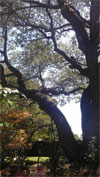Question and Answer – October 2012
Neil’s help is as close as an e-mail to e-gardens. Send it here. However, please do attach a photo to the e-mail, as Neil requires them for this visual medium. If a photo just isn’t possible, please contact Neil through one of his weekend radio programs.
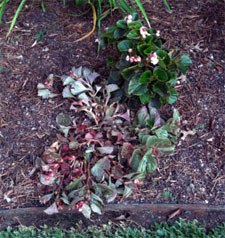
Question: For three years, I’ve had bronze-leafed wax begonias in the front of our wide bed. The plants do get sunlight, and they seem to thrive until late July. At that point, they start falling over, as if something might be eating their stems. What might be happening, and what can I do another year? C., University Park.
Answer: My bet would be that they’re getting more sunlight and heat than they can tolerate. I see it all over Texas by mid-summer, and I don’t recall ever seeing an insect or disease. In the spring, pillbugs will chew the bottoms of the stems, almost like little beavers, but the damage you’ve shown just looks like a sudden collapse under the stress of summer conditions. I see it especially where begonias are watered while the hot sun is hitting them. They do best with a couple of hours of morning sun (before 10) and in moist, highly organic soil.
Question: What’s left of my squash plants has been invaded by some type of disease. Do you recognize it? It’s predominantly on the undersides of the leaves. J.W., Aledo area.
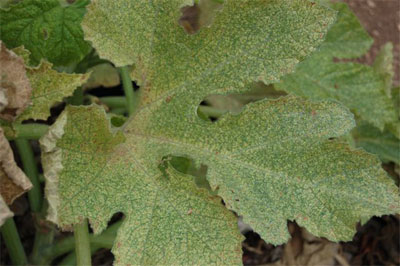
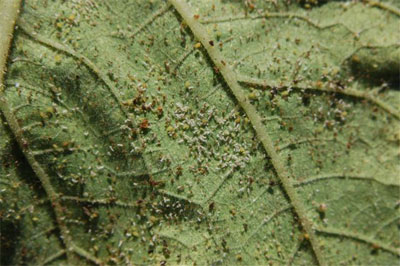
Answer: This is a classic example of spider mites, and your photos are fabulous. The tan mottling is typical of their damage, and the photo of the bottom side of the leaf even shows the tiny mites themselves. You could put 20 mites on the head of a pin, yet your photo does show them. Spring plantings of squash will run their course by mid-June. From that point on, I wouldn’t advise trying to spray for the problem. General-purpose insecticides don’t give perfect control, but they will help.
Question: I have three 30-year-old live oaks. One of the three is about 60 percent the height of the others, and it’s really quite gnarly. Do you think it’s a different species of live oak, or is the difference just genetic? J.B., Plano.
Answer: The latter. Live oaks are wind-pollinated, and I know of no other species of tree that varies as much as live oaks. You’ll see all sizes of leaves, and all types of growth forms, from rounded to almost weeping. This is simply a tree with its own personality. Enjoy it — I know you do.
Question: I am about to pour concrete to get rid of spurge in my landscape. I sprayed 20 percent vinegar for weeds in the mulched beds, and I had corn gluten meal put out earlier in September as a pre-emergent. I’m assuming the reason I have such a heavy crop of spurge this year is because the corn gluten meal wasn’t applied at the proper time. Any advice? J.J., Azle.
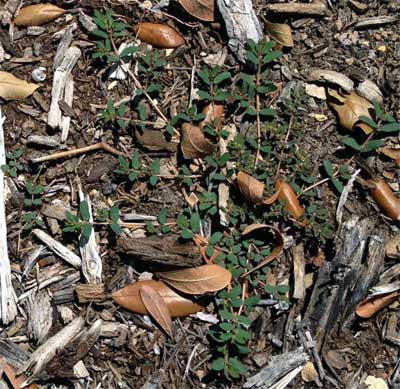
Answer: I have to admit that of all the weeds I might have in my lawn or landscape, spurge would worry me less than any of the others. For what it’s worth, I do not accept advertising for either vinegar or corn gluten meal, because I do not believe that they work. And, just for the record, if a pre-emergent were going to be effective on this weed, it would have to be applied in the spring and again in early summer. The product that would work is a broadleafed pre-emergent called Gallery. It’s a great preemergent for control of annual broadleafed weeds, but I don’t use it for spurge. I simply put out a 1- to 2-inch layer of pine bark mulch, and I rarely have spurge germinate and grow. If it does, I quickly scrape it off with a hoe. It does not come back from its roots once the top is cut. In open spaces, you could also apply a broadleafed weedkiller. I really rerouted the answer. I hope it’s of help.
Question: Everyone has told me that hollies are extremely hardy in cold and heat, but mine are really struggling. What is the problem? R.A., Little Elm.
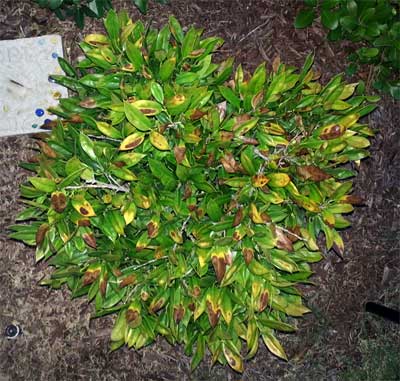
Answer: This is Carissa holly, and it has become one of the go-to landscaping shrubs for big parts of Texas. This is sunscald, perhaps with a bit of drought damage thrown in. My 35 years of experience with Carissa holly have caused me not to plant it against hot, reflective surfaces like sunny brick walls and full-sun sidewalks, patios and drives. Where it’s surrounded by turf or groundcovers, it does well, and with morning sun and shade in the afternoon, it’s a wonderful choice. I have probably 75 of them in my own landscape, and I’ve been very happy with them, but they all have at least a small measure of afternoon protection from the intense summer sun.
Question: I have lived in my house for 20 years, and my St. Augustine has always done well. However, for the past three years, it has developed these spots. Is this a fungus? Should I change my watering schedule? I water twice a week, 40 minutes per station, 10 stations. M.H., Fort Worth.
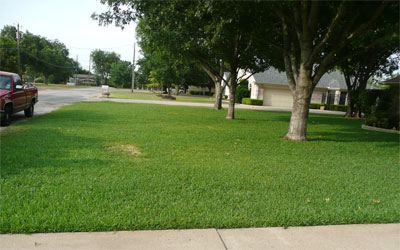
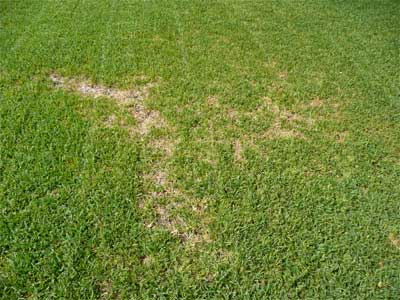
Answer: This is almost assuredly chinch bugs. They show up in the hottest, sunniest part of the yard, and they appear July through mid-September. The grass appears dry, yet watering doesn’t resolve it. You can see the b-b-sized black insects with irregular white diamonds on their backs if you part the runners of the dying grass on a hot summer afternoon. By now, the chinch bugs are gone for this year. They do serious damage, and they do it quickly. Next year, apply a labeled insecticide at first signs of the drying — long before it gets to this point. Also, you might consider having a "smart" controller installed. It sounds like you’re applying a great deal of water — perhaps more than the grass would require. The several hundreds of dollars the new controller would cost might be repaid within the first year or two.
Question: I planted these honeysuckle vines on this fence last summer, and I have seen no blooms at all this summer. I’m planning on replacing them with something that will bloom all summer. What do you suggest? S.S., Allen.
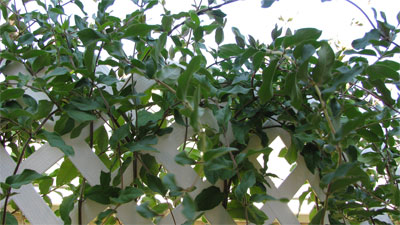
Answer: Yikes. That’s a rough request. Most vines have a peak season of bloom, usually only for two or three weeks. For honeysuckle, that’s going to be in April. These will be loaded with fragrant flowers for a couple of weeks at that time. You’ll see occasional blooms after that, but not many. I would encourage you not to rush out to remove these plants yet. Give them next year to see if you don’t like them more. They probably were busily growing vegetatively this past spring. You should get good flower production next April. As for a non-stop flowering vine, Madame Galen trumpet creeper is as close as I can come. However, it’s a very large and heavy vine — no match for latticework. You really might be better served by planting hyacinth bean seeds each spring. That’s the purple-leafed annual vine you’ll see around town right now. The foliage is lovely, and the flowers are also maroon, as are the conspicuous seedpods. I just don’t think you’re going to find a good woody vine that blooms continuously and that wouldn’t pull down your latticework. Carolina jessamine blooms in early spring. It is evergreen, and it is the most refined of any of our woody vines.
Question: We bought a new house last year. In February 2011, the landscaper planted three red oak trees. They are shown in the photos, in June in the left photo and in late August in the right photo each time. They are alive, but not growing. Is this due to improper watering (three times per week via the bags), or insufficient feeding (lawn food)? Or, something else? K.W., Frisco.
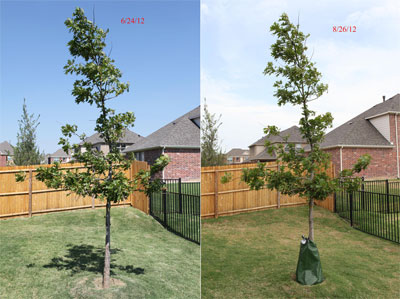
Answer: I would say that your trees probably got too dry at one point or another in the past 18 months. That’s easy to let happen, when you take a tree that’s somewhat rootbound and plant it from a pot into the soil. If they get too dry, it will shut them down and cause them to have to restart their growth. I’m not a big fan of the bags. I prefer to water new trees the old-fashioned way — by letting the hose fill a shallow basin around the tree, or at least letting the water soak deeply into the soil. You want to add an all-nitrogen fertilizer to promote new growth, and you really need to wrap their trunks with paper tree wrap from the nursery to protect against sunscald and borers. They should have been wrapped when they were planted, with the wrap remaining in place until the leaf canopy could provide shade.
Question: When I bought this purple smoketree, the nurseryman assured me it was a shrub and that it could be kept at a good height beneath my eaves. How would I go about keeping it at 6 or 7 feet? This is its second year. N.P., Waxahachie.
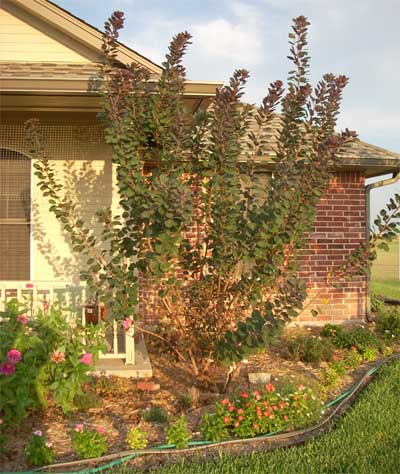
Answer: Smoketrees are large shrubs that we sometimes train as small trees. Honestly, if I had seen a photo of your home before it was landscaped, I might have recommended the same plant. However, I would have planted it 8 or 9 feet out from the corner of the house, so it would act more to frame the house visually, not just to grow up against it. Still, you can trim it as a shrub. Use hand shears and loppers to shorten one branch at a time. Vary the cutting heights, so the plant won’t look like it’s been mowed off. Do this in mid-winter, when you can see the branch patterns and bud placements most easily. Each cut should be made just above a bud that you want to grow and become dominant, just as you would do for a bush rose. However, the best long-term solution to your issue would be to dig and relocate the plant sometime this winter. Move it out by 5 or 6 more feet, and perhaps change the path of the edging to accommodate it.
Question: Our chili pepper plants have crinkled leaves and are very stunted. What can we do? C.C., San Antonio.
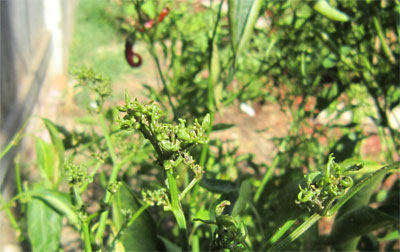
Answer: There may be a virus involved here, but it appears to me that you have thrips all over your plants. Commercial growers spray their ornamental pepper plants, especially to stop these disfiguring pests and the diseases they spread. Use a product labeled for thrips, and be prepared to spray more than once. Next season, try to stay ahead of the issue.
Question: Two years ago we were advised to plant dwarf mondograss beneath our trees. It has continued to die, in spite of extra care and watering. Now, we’re wondering what other plant would be a better choice. Should we put a weed-blocking fabric down first? House faces north, but there is late afternoon sun. L.M,. No city given.
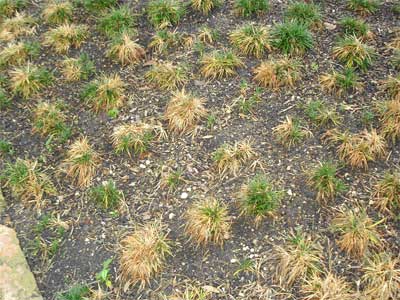
Answer: I’m not a fan of dwarf mondograss (not a true grass) in large beds. It’s too slow and too picky. By comparison, I have used tons and tons of regular mondograss in my shaded beds. It could tolerate a little bit of afternoon sun (an hour or so), but it’s better in the shade. Consider purple wintercreeper euonymus as a trailing groundcover. It’s a bit more difficult to get leaves out of it than with mondograss, but it handles both sun and shade. Perhaps you could design an attractive bed that would include portions of each, wintercreeper in the sunnier areas and mondograss in the shade. Do not use the weedblocking fabric. You want the groundcover to be able to spread and root into the soil. Hand-pull any weeds that do show up for the first year or so.
Question: We planted three climbing roses on the front of our arbor three years ago. They bloomed beautifully last spring, but they have grown too tall and very strongly. I can’t reach to trim them on top (at least 6 feet tall). I’m considering removing them entirely and letting the wisterias I planted on the back of the arbor grow to cover it. As it is now, the roses have outgrown them. Any suggestions? C.H., no city given.

Answer: Both plants are strong growers, so in the long run, it may be two versions of the same question. The roses do send out longer, arching shoots, while the wisteria would tend to stay closer to the support. However, there are pruning tools that could easily reach up and over the roses, either with a lightweight lopping pole pruner or with a long-handled hedge trimmer. They can be pruned. I wouldn’t think you would have to do so more than a couple of times during a growing season. I like both plants, but the roses are obviously happy with their surroundings. I really would try to figure a way to keep them.
Question: We’ve been in our house for six years. This oak is around 30 years old. Every year, the yellowing seems to get worse. Is it something we should be worried about? S.B., Yukon, OK.
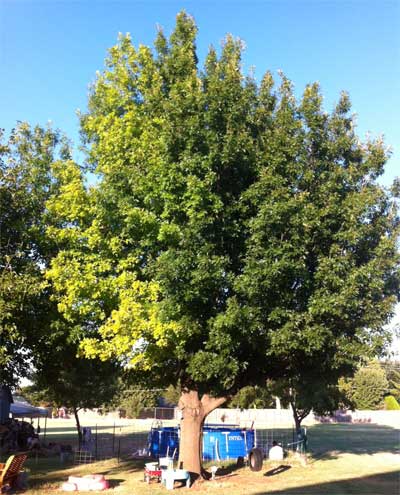
Answer: It does look like iron deficiency, but that doesn’t necessarily mean that you should add iron to the soil. It may be that there has been some type of root or trunk damage or decay that has kept the tree from carrying iron from the soil to its leaf canopy on that side of the tree. Check closely. If you’d like to try an iron additive with a sulfur soil-acidifier included, that would give you some idea of whether that would help. If it doesn’t, you probably should call in a certified arborist. Finally, as I always caution people, there are all types of "red" oaks. Shumard red oaks are the most common type native to alkaline soils. Pin oaks look very similar to Shumard red oaks, but they require acidic soil. They would develop iron deficiency in areas with alkaline soils, and I would guess that Yukon, being west of Oklahoma City, would fit into that category. Have your certified arborist confirm the type of oak that you have.


